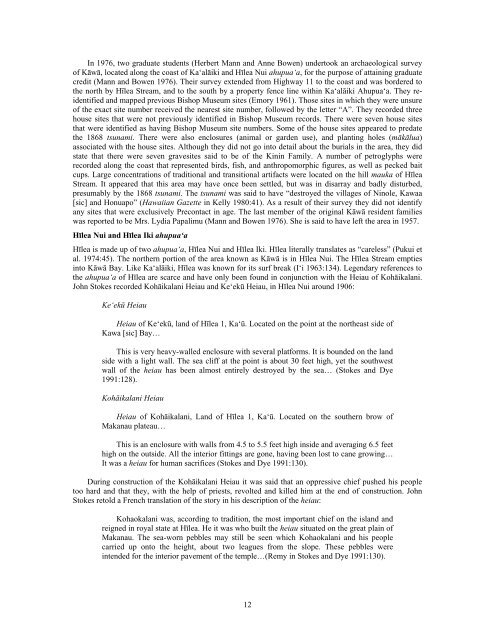Honu'apo Park Resource Management Plan
Honu'apo Park Resource Management Plan
Honu'apo Park Resource Management Plan
Create successful ePaper yourself
Turn your PDF publications into a flip-book with our unique Google optimized e-Paper software.
In 1976, two graduate students (Herbert Mann and Anne Bowen) undertook an archaeological survey<br />
of Kāwā, located along the coast of Ka‘alāiki and Hīlea Nui ahupua‘a, for the purpose of attaining graduate<br />
credit (Mann and Bowen 1976). Their survey extended from Highway 11 to the coast and was bordered to<br />
the north by Hīlea Stream, and to the south by a property fence line within Ka‘alāiki Ahupua‘a. They reidentified<br />
and mapped previous Bishop Museum sites (Emory 1961). Those sites in which they were unsure<br />
of the exact site number received the nearest site number, followed by the letter “A”. They recorded three<br />
house sites that were not previously identified in Bishop Museum records. There were seven house sites<br />
that were identified as having Bishop Museum site numbers. Some of the house sites appeared to predate<br />
the 1868 tsunami. There were also enclosures (animal or garden use), and planting holes (mākālua)<br />
associated with the house sites. Although they did not go into detail about the burials in the area, they did<br />
state that there were seven gravesites said to be of the Kinin Family. A number of petroglyphs were<br />
recorded along the coast that represented birds, fish, and anthropomorphic figures, as well as pecked bait<br />
cups. Large concentrations of traditional and transitional artifacts were located on the hill mauka of Hīlea<br />
Stream. It appeared that this area may have once been settled, but was in disarray and badly disturbed,<br />
presumably by the 1868 tsunami. The tsunami was said to have “destroyed the villages of Ninole, Kawaa<br />
[sic] and Honuapo” (Hawaiian Gazette in Kelly 1980:41). As a result of their survey they did not identify<br />
any sites that were exclusively Precontact in age. The last member of the original Kāwā resident families<br />
was reported to be Mrs. Lydia Papalimu (Mann and Bowen 1976). She is said to have left the area in 1957.<br />
Hīlea Nui and Hīlea Iki ahupua‘a<br />
Hīlea is made up of two ahupua‘a, Hīlea Nui and Hīlea Iki. Hīlea literally translates as “careless” (Pukui et<br />
al. 1974:45). The northern portion of the area known as Kāwā is in Hīlea Nui. The Hīlea Stream empties<br />
into Kāwā Bay. Like Ka‘alāiki, Hīlea was known for its surf break (I‘i 1963:134). Legendary references to<br />
the ahupua‘a of Hīlea are scarce and have only been found in conjunction with the Heiau of Kohāikalani.<br />
John Stokes recorded Kohāikalani Heiau and Ke‘ekū Heiau, in Hīlea Nui around 1906:<br />
Ke‘ekū Heiau<br />
Heiau of Ke‘ekū, land of Hīlea 1, Ka‘ū. Located on the point at the northeast side of<br />
Kawa [sic] Bay…<br />
This is very heavy-walled enclosure with several platforms. It is bounded on the land<br />
side with a light wall. The sea cliff at the point is about 30 feet high, yet the southwest<br />
wall of the heiau has been almost entirely destroyed by the sea… (Stokes and Dye<br />
1991:128).<br />
Kohāikalani Heiau<br />
Heiau of Kohāikalani, Land of Hīlea 1, Ka‘ū. Located on the southern brow of<br />
Makanau plateau…<br />
This is an enclosure with walls from 4.5 to 5.5 feet high inside and averaging 6.5 feet<br />
high on the outside. All the interior fittings are gone, having been lost to cane growing…<br />
It was a heiau for human sacrifices (Stokes and Dye 1991:130).<br />
During construction of the Kohāikalani Heiau it was said that an oppressive chief pushed his people<br />
too hard and that they, with the help of priests, revolted and killed him at the end of construction. John<br />
Stokes retold a French translation of the story in his description of the heiau:<br />
Kohaokalani was, according to tradition, the most important chief on the island and<br />
reigned in royal state at Hīlea. He it was who built the heiau situated on the great plain of<br />
Makanau. The sea-worn pebbles may still be seen which Kohaokalani and his people<br />
carried up onto the height, about two leagues from the slope. These pebbles were<br />
intended for the interior pavement of the temple…(Remy in Stokes and Dye 1991:130).<br />
12


